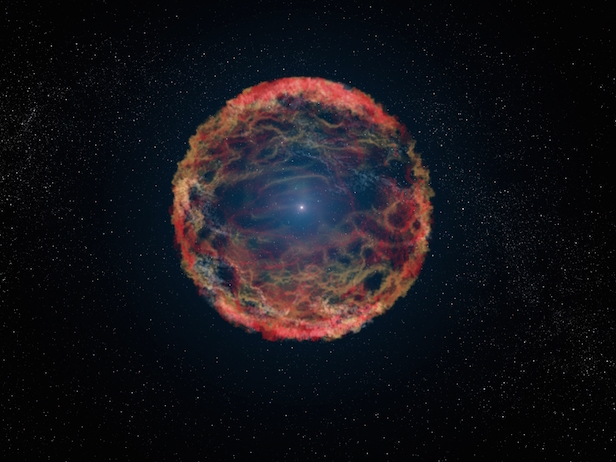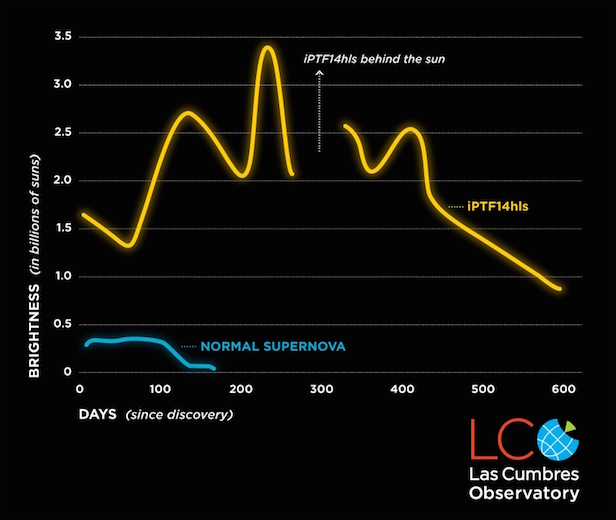Astronomers discover star that won’t die
Supernovae traditionally occur once at the end of a star’s life, but this particular star has exhibited multiple supernovae over the last three years

A supernova normally marks the end of stars life, as it expels its outer layers of material. Image credit: NASA/ESA/G. Bacon (STSCL)
An international team of astronomers have discovered a bizarre star that refuses to stop shining, despite the fact it’s exploded several times over the course of 50 years.
When a star reaches the end of its life, it will expel its outer layers in an explosive fashion, and this is known as a supernova. A supernova most commonly marks the death of a star, but astronomers at Las Cumbres Observatory (LCO) have discovered an anomaly that challenges this theory about the death of stars.
“This supernova breaks everything we thought we knew about how they work,” says Iair Arcavi, a NASA Einstein postdoctoral fellow in UC Santa Barbara’s Department of Physics and at LCO. “It’s the biggest puzzle I’ve encountered in almost a decade of studying stellar explosions.”
Discovered in September 2014, the supernova iPTF14hls was found using the Caltech-led Palomar Transient Factory, and at first glance it appeared to be an ordinary supernova. A normal supernova shows a rise to peak brightness, followed by a gradual fading, over 100 days. In this case, the team of astronomers noticed the star increased in brightness and then dimmed again at least five times in just over three years. This is a phenomenon never seen before.
When scientists delved deeper into the archives, they were incredibly surprised to find evidence for an explosion in the same location in 1954. This indicates that the star exploded over 50 years ago, and then exploded again in 2014. From this study, the astronomers calculated the exploding anomaly was originally at least 50-times the mass of our Sun, and was most probably much larger in size.
“Supernova iPTF14hls may be the most massive stellar explosion ever seen,” explains Lars Bildsten, director of UC Santa Barbara’s Kavli Institute for Theoretical Physics. “For me, the most remarkable aspect of this supernova was its long duration, something we have never seen before. It certainly puzzled all of us as it just continued shining.”

iPTF14hls clearly shows a much more irregular brightness variation when compared to a normal supernova explosion. Image credit: LCO/S. Wilkinson
One possible explanation is that iPTF14hls is the first example of a pulsational pair-instability supernova, a theory that was strengthened by the realisation of its 1954 explosion. This theory states that the cores of massive stars burn so hot that energy is converted into matter and antimatter. This could cause an explosion of the star’s outer layers while leaving the core intact. This process would be repeated over decades until there is a final explosion, and the star eventually collapses into a black hole.
“These explosions were only expected to be seen in the early universe and should be extinct today,” says Andy Howell, leader of the supernova group at LCO. “This is like finding a dinosaur still alive today. If you found one, you would question whether it truly was a dinosaur.”
The pulsational pair-instability theory doesn’t fully explain everything in the data collected, however. A major unexplained aspect is that the energy released by the supernova is more than what the theory predicts. This indicates that iPTF14hls could be a completely new kind of supernova.
Astronomers continue to observe iPTF14hls, which still remains bright three years after its discovery. The LCO network is, and will continue to be, ideal for such observations, as it is a global network of telescopes that can provide constant observations. This has allowed astronomers to observe the supernova every few days for the last few years, and they will remain vigilant.
“We could not have kept tabs on iPTF14hls for this long and collected data that challenges all existing supernova theories if it weren’t for the global telescope network,” says Arcavi. “I can’t wait to see what we’ll find by continuing to look at the sky in the new ways that such a setup allows.”
Keep up to date with the latest reviews in All About Space – available every month for just £4.99. Alternatively you can subscribe here for a fraction of the price!




